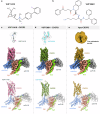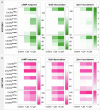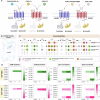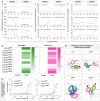Structural visualization of small molecule recognition by CXCR3 uncovers dual-agonism in the CXCR3-CXCR7 system
- PMID: 40155369
- PMCID: PMC11953467
- DOI: 10.1038/s41467-025-58264-w
Structural visualization of small molecule recognition by CXCR3 uncovers dual-agonism in the CXCR3-CXCR7 system
Abstract
Chemokine receptors are critically involved in multiple physiological and pathophysiological processes related to immune response mechanisms. Most chemokine receptors are prototypical GPCRs although some also exhibit naturally-encoded signaling-bias toward β-arrestins (βarrs). C-X-C type chemokine receptors, namely CXCR3 and CXCR7, constitute a pair wherein the former is a prototypical GPCR while the latter exhibits selective coupling to βarrs despite sharing a common natural agonist: CXCL11. Moreover, CXCR3 and CXCR7 also recognize small molecule agonists suggesting a modular orthosteric ligand binding pocket. Here, we determine cryo-EM structures of CXCR3 in an Apo-state and in complex with small molecule agonists biased toward G-proteins or βarrs. These structural snapshots uncover an allosteric network bridging the ligand-binding pocket to intracellular side, driving the transducer-coupling bias at this receptor. Furthermore, structural topology of the orthosteric binding pocket also allows us to discover and validate that selected small molecule agonists of CXCR3 display robust agonism at CXCR7. Collectively, our study offers molecular insights into signaling-bias and dual agonism in the CXCR3-CXCR7 system with therapeutic implications.
© 2025. The Author(s).
Conflict of interest statement
Competing interests: The authors declare no competing interests.
Figures










References
-
- Viola, A. & Luster, A. D. Chemokines and their receptors: drug targets in immunity and inflammation. Annu Rev. Pharmacol. Toxicol.48, 171–197 (2008). - PubMed
-
- Rossi, D. & Zlotnik, A. The biology of chemokines and their receptors. Annu Rev. Immunol.18, 217–242 (2000). - PubMed
-
- O’Hayre, M., Salanga, C. L., Handel, T. M. & Allen, S. J. Chemokines and cancer: migration, intracellular signalling and intercellular communication in the microenvironment. Biochem J.409, 635–649 (2008). - PubMed
MeSH terms
Substances
Grants and funding
- IA/S/20/1/504916/DBT India Alliance (Wellcome Trust/DBT India Alliance)
- IPA/2020/000405/DST | Science and Engineering Research Board (SERB)
- SPR/2020/000408/DST | Science and Engineering Research Board (SERB)
- F.NO.52/15/2020/BIO/BMS/Indian Council of Medical Research (ICMR)
- 23KJ0491/MEXT | Japan Society for the Promotion of Science (JSPS)
- 22K19371/MEXT | Japan Society for the Promotion of Science (JSPS)
- 22H02751/MEXT | Japan Society for the Promotion of Science (JSPS)
- 21H05037/MEXT | Japan Society for the Promotion of Science (JSPS)
- JP22ama121012/Japan Agency for Medical Research and Development (AMED)
- JP22ama121002/Japan Agency for Medical Research and Development (AMED)
LinkOut - more resources
Full Text Sources

